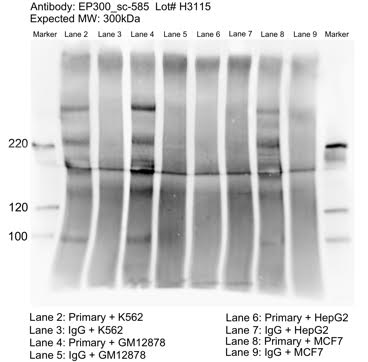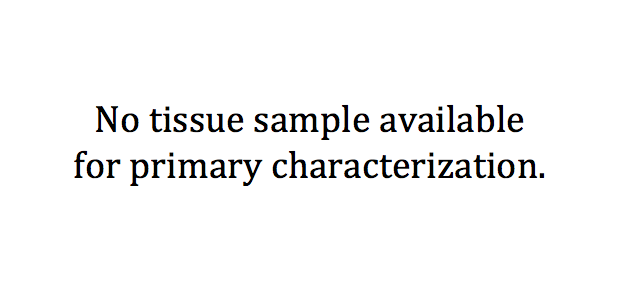ENCAB284TTY
Antibody against Homo sapiens EP300
Homo sapiens
K562, GM12878
characterized to standards
Homo sapiens
transverse colon, stomach, subcutaneous adipose tissue, omental fat pad, sigmoid colon, esophagus muscularis mucosa, gastroesophageal sphincter, upper lobe of left lung, suprapubic skin, ovary, testis, prostate gland, breast epithelium, vagina, tibial nerve
characterized to standards with exemption
Homo sapiens
HepG2, MCF-7
not characterized to standards
- Status
- released
- Source (vendor)
- Santa Cruz Biotech
- Product ID
- sc-585
- Lot ID
- H3115
- Characterized targets
- EP300 (Homo sapiens)
- Host
- rabbit
- Clonality
- polyclonal
- Purification
- affinity
- Isotype
- IgG
- Antigen description
- epitope mapping at the C-terminus of p300 of human origin
- External resources
Characterizations
EP300 (Homo sapiens)
Method: immunoprecipitation followed by mass spectrometry
compliant
- Reviewer comment
- Compliant Mass Spec for a secondary characterization of ENCAB284TTY
- Submitted by
- Mark Mackiewicz
- Lab
- Richard Myers, HAIB
- Grant
- U54HG006998
- Download
- EP300-H3115-WL.xlsx - Sheet1.pdf
EP300 (Homo sapiens)
K562GM12878HepG2MCF-7
compliant
- Caption
- Whole cell lysates of K562, GM12878, MCF7 and HepG2 were immunoprecipitated using the primary antibody (Santa Cruz Biotechnology; sc-585; Lot# H3115). The IP fraction was separated on a 12% acrylamide gel with the Bio-Rad PROTEAN II xi system. After separation, the samples were transferred to a nitrocellulose membrane with an Invitrogen iBlot system. The membrane was probed with the primary antibody (same as that used for IP) and a secondary HRP-conjugated antibody. The resulting bands were visualized with SuperSignal West Femto Solution (Thermo Scientific). Protein Marker (PM) is labeled in kDa. The approximate size of EP300 is ~300 kDa.
- Submitted by
- Mark Mackiewicz
- Lab
- Richard Myers, HAIB
- Grant
- U54HG006998
- Download
- EP300_sc-585_LotH3115.jpg
EP300 (Homo sapiens)
transverse colonstomachsubcutaneous adipose tissueomental fat padsigmoid colonesophagus muscularis mucosagastroesophageal sphincterupper lobe of left lungsuprapubic skinovarytestisprostate glandbreast epitheliumvaginatibial nerve
exempt from standards
- Caption
- The ENCODE Binding Working Group finds for some valuable tissues that recreating a primary on well characterized antibodies is not cost effective. Therefore, they allow exemption from standards for these tissues. Compliant characterizations in other cell lines may be used instead.
- Submitter comment
- The lab is asking for an exemption for transverse colon, stomach, subcutaneous adipose, and omental fat pad tissues due to the lack of resources to make a primary characterization for them
- Reviewer comment
- --
- Submitted by
- Mark Mackiewicz
- Lab
- Richard Myers, HAIB
- Grant
- U54HG006998
- Download
- No_tissue.png

